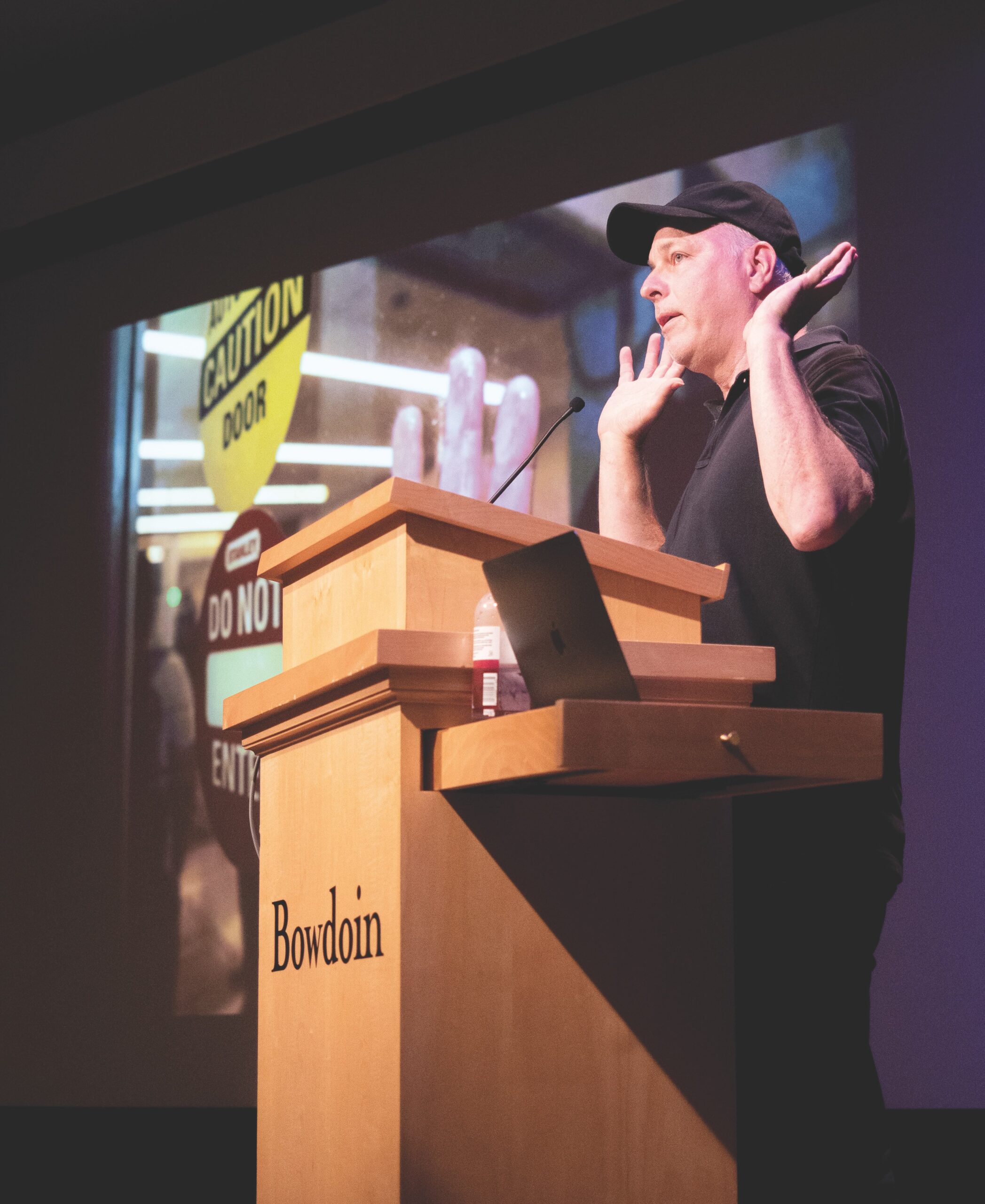TJ Demos speaks on the aesthetics of climate justice
September 16, 2022
 Alex Spear
Alex SpearMembers of the Bowdoin and Brunswick communities gathered in Kresge Auditorium on Tuesday afternoon for “Emergency of Emergencies: The Aesthetics and Politics of Climate Justice.” The talk was given by TJ Demos, a professor of art history at the University of California, Santa Cruz. Demos spoke on his research on contemporary art, which advocates for climate justice inextricably contextualized by issues like racial and economic inequity. He also touched on the language of climate justice and where it originated from.
Students were drawn in by the importance and urgency of climate justice.
“I remember seeing the title and thinking, ‘That’s something I don’t know a lot about but that interests me,’” Patrick B. Sullivan ’26 said.
“It’s really relevant and important right now, and I also wanted to learn something new,” Prathit Kurup ’26 said.
The talk was organized in coordination with the Bowdoin College Museum of Art’s (BCMA) “At First Light” exhibit, which focuses on the environment and the peoples of Maine over the last two centuries. In his presentation, Demos analyzed pieces of contemporary experimental media in the form of film, maps and protest signs. Most material was sourced from the website of the environmental movement “Extinction Rebellion” and the art collective “The Otolith Group.”
“At First Light” curator and BCMA co-director Anne Goodyear has been influenced by Demos’ focus on the anthropocene, or how humans’ interaction with the environment has transformed both the environment itself and how we experience it.
“Demos’ work has helped sensitize me to the ways in which the landscape is depicted,” Goodyear said. “Ways in which artists, particularly artists of European descent, especially in the early part of statehood, are eager to create representations of the landscape that speak to human actions as a sign of ‘progress.’”
Goodyear spoke further on “At First Light” as it relates to Demos’ talk.
“I think there are artworks later in the exhibition, such as work by Berenice Abbott and Yvonne Jacquette, that raise very profound questions about our intersection with the ecology of the area,” Goodyear said. “I have found that Demos’ work has helped me to rethink what it means to experience and depict the landscape at large, including here in Maine.”
Professor of Art James J. Mullen, who has a piece in the “At First Light” exhibit and attended the Demos talk, also appreciated the knowledge Demos shared.
“[Demos’] extensive familiarity with many different contemporary groups dealing with environmental issues is a great resource, as is his extensive familiarity with all the micro-climates of conversation between them,” Mullen wrote in an email to the Orient.
“Ecology is a science of social as much as natural relations,” Demos said.
He emphasized that thinking about climate change without situating its effects within the context of historical oppression creates a rift zone that compounds oppression.
During a discussion period in the latter half of the event in which the audience posed questions for Demos, an audience member asked about the inaccessibility of academic language and the tendency to feel overwhelmed in the face of an issue as pressing and heavy as climate justice. Demos acknowledged that different language is needed to make the issue more accessible, but noted that activism did not originate from theorists but from frontline communities. He cited the houseless population of Santa Cruz, where he resides, who don’t need academic language to understand and express that they disproportionately have to breathe polluted air.
The inability to breathe was a prominent theme throughout Demos’ presentation. In a haunting clip he showed from the Otolith Group’s experimental film “INFINITY Minus Infinity,” the phrase “I can’t breathe,” is spoken repeatedly. The expression has multiple meanings in the racialized geographies of breathing space.
“Watching the three black women acting out the words, ‘I Can’t Breathe’ with background music that evoked trauma, over and over again, with their eventual fade away, was an ‘ALERT’ in capital letters that told of the existing cultural racism, and the varied, unsuitable places of habitation for people of color or the non-privileged,” attendee Carol Markell of Brunswick wrote in an email to the Orient.
Demos drew the Q&A portion to a close with the refusal to answer an artist who asked what he could do to make a difference. It is the same question Demos’ students often ask him and is the consequence of his position at the front of the room, disseminating information. This is an uncomfortable role for Demos. He hopes that he can displace himself and work as an equal with all those who ask what they can do in order to figure out the answers together.

Comments
Before submitting a comment, please review our comment policy. Some key points from the policy: